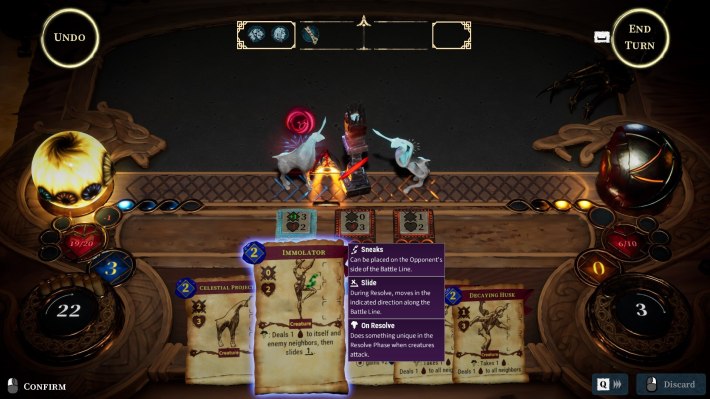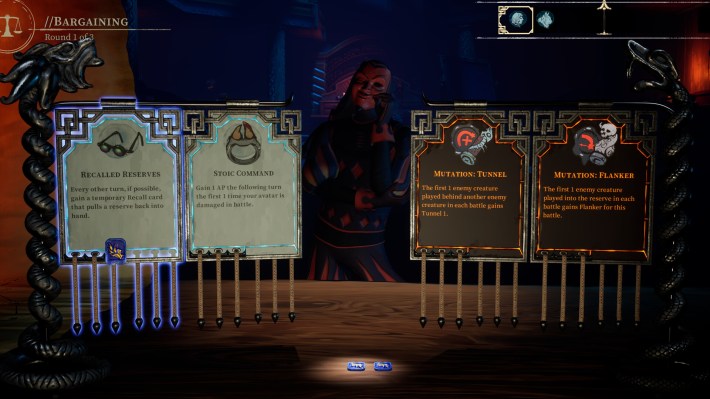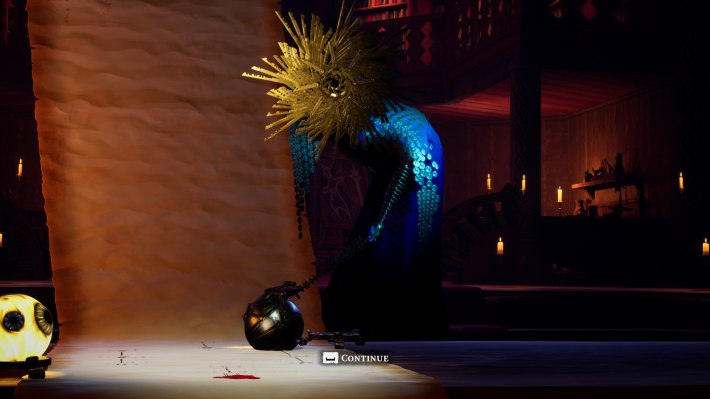I had a brief but intense Gwent phase, playing The Witcher 3’s monster-based card game a whole lot but pretty badly. The Killing Stone reminds me a bit of Gwent in that there are cards and monsters and after I make my play I watch the enemy’s monsters wallop me while I yell “wait, no!” helplessly at my screen, but it stands out with a wonderfully physical board game feel and a narrative that infuses its design.
The Killing Stone, which has a demo out now as part of Steam Next Fest, puts you in a contest against the devil for the souls of your deceased mentor and her family. There’s a narrative that you play in between matches of its in-game game, in which you walk around a dark 17th century mansion and choose among dialogue options that can be rendered in either modern or period English. The game-within-the-game takes place on a table and paper map, where you play cards to deploy tiny figures of monsters, and try to destroy your enemy’s “eye”–basically their main health pool–before they can destroy yours.
Everything in the game is wonderfully physical: pens scratch and figurines rattle, and the sound design comes really close to making you feel like you’re actually touching the objects on the board. You have a limited amount of action points and space to play your various creatures in a row. Some of them are just monsters who do damage, while others have special abilities. I became very fond of the Sacrificial Lamb, a weak sheep I’d basically set up to die to trigger its ability to give me extra action points, and the Immolator, which can be placed on the enemy’s side of the board to damage them as it moves along. Your pieces also have a Reserve slot above the board you can place a piece or power into; these can buff that piece or deploy when that piece is destroyed to give you additional effects. The order you play your monsters and reserves in matters, as they can affect each other, and they also stand as a physical buffer between the enemies and your eye. The best plays are those that strategically arrange your pieces to do multiple things at once, taking care of troublesome enemies while also chaining effects or setting you up for the next turn.

On top of these battles is a sort of meta game, which you progress through by picking a path along a paper map. There’s a lot there: there are healing rooms and a place to swap out decks; “familiar” characters like a raven and a dog give you run-long benefits; and you can use chits to “wager” on buffs and against your opponent’s buffs. I liked the way this stuff was dressed up in the whole game’s narrative of deals and bargains with nefarious creatures, though the jargon did sometimes overwhelm me a bit. I definitely didn’t come close to mastering any of it in my time with the demo, but it hints at the ability to really craft your run once you have.

My favorite parts of The Killing Stone are how physical everything is, and how strong the game’s world and vibe are. I might be dreadful at the wagering for boons and buffs, but I love how the chits fall with a rattle, and how the system plays with hidden information in a similar manner to an actual game round. I lost continuously to the demo’s first nemesis, but I couldn’t get enough of its evocative design and the metallic clinking of its erector set face.

There is a lot going on in The Killing Stone, with its various narratives and multiple mechanics, but they all tie together in a way that feels consistent. Gwent was always “people in this world like to play cards,” but The Killing Stone’s game is a piece of the full game’s narrative as much as a game and story of its own. I’m excited to spend more time with the demo and learn to overcome my fatal instinct in games like this to just click things that look exciting instead of really thinking it all through. Steam Next Fest runs through October 20.


